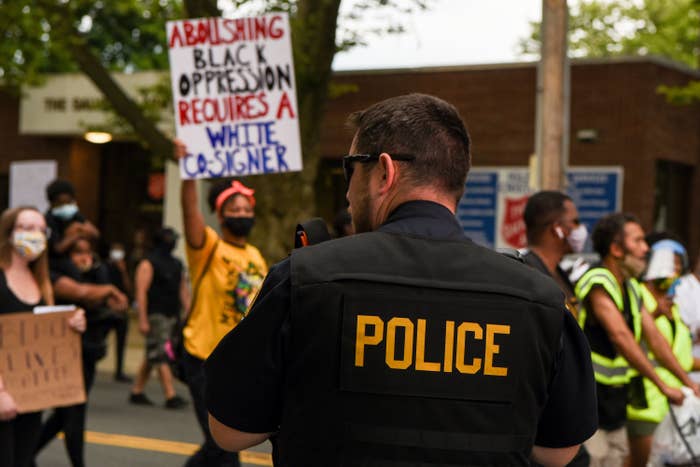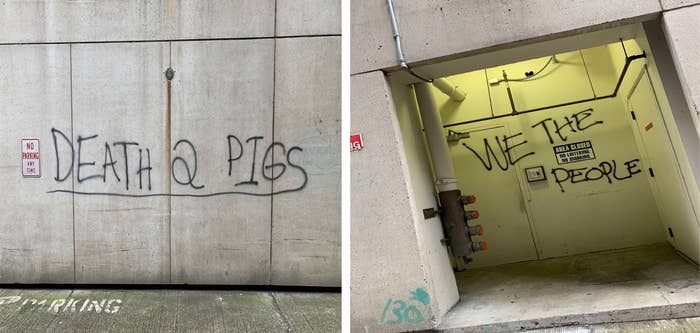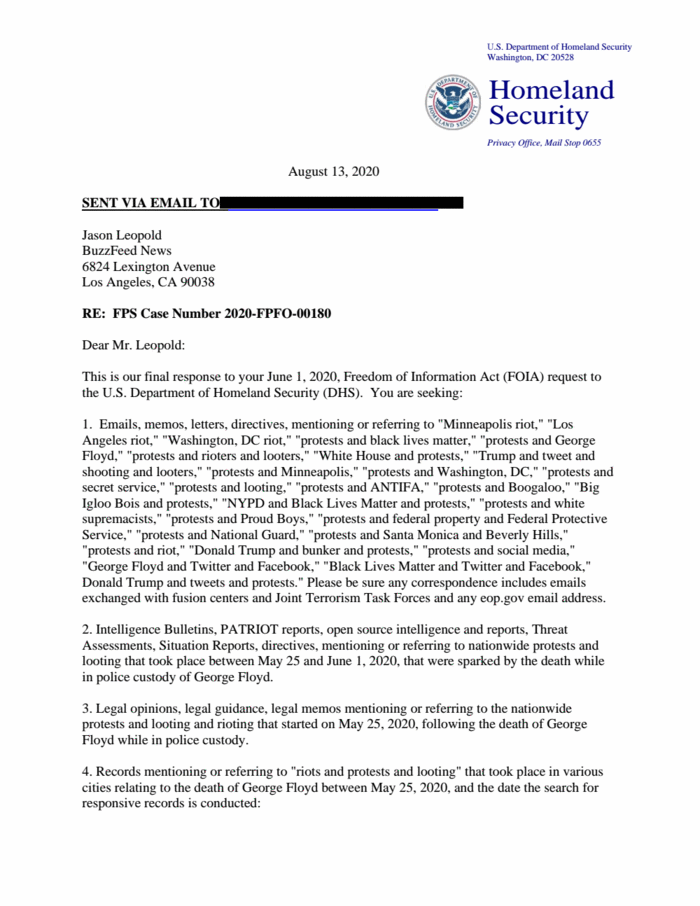
The email from the Federal Protective Service commander in Philadelphia was stark and alarming: “Apparent anarchists are numerous and are attacking banks, public structure, and statues,” he wrote on May 30, under the subject line “Ongoing Violence toward Law Enforcement.” “They are discussing burning down the Federal Reserve.”
As the country erupted in protest after a Minneapolis police officer killed George Floyd on May 25, the federal government scrambled to respond, dispatching a range of federal law enforcement agencies in a sweeping effort to police the demonstrations from coast to coast. In Portland, Oregon, and Washington, DC, those efforts drew widespread condemnation after videos showed authorities using tear gas against protesters and, in Portland, detaining them inside unmarked vans. Records obtained by BuzzFeed News through the Freedom of Information Act reveal that officers from at least one federal agency, the Federal Protective Service, a division within the Department of Homeland Security, arrived at protest scenes braced for combat.
The mission of the FPS is to “prevent, protect, respond to, and recover from terrorism, criminal acts and other hazards threatening” the US government and its infrastructure.
Officials at the FPS did not immediately respond to a request for comment. BuzzFeed News requested all records pertaining to the protests; the agency’s response indicated that some documents were withheld because of ongoing law enforcement investigations.
An “Information Bulletin” issued May 29 by the FPS investigations branch warned that “many of these demonstrations will continue to include destruction and/or violence” and that “participants may be wielding rudimentary weaponry and improvised incendiary devices” and “may conduct their attack if an opportunity exists.”

FPS records show that top officials from the Department of Homeland Security, including DHS’s undersecretary of management, Randolph “Tex” Alles, the former head of the Secret Service, were provided daily updates on the protests and the impact the demonstrations had on federal property.
Agents monitored social media for “intelligence” on upcoming Black Lives Matter demonstrations in Minneapolis, DC, LA, and elsewhere, cataloging Facebook and Instagram posts announcing protests and logging the number of people who expressed interest in attending.
“I have not found any information regarding PLANNED violence/destruction for any of these events,” an FPS intelligence research specialist wrote in an email listing upcoming protests in Minneapolis.
In at least one case, authorities used social media posts to try to identify protesters who may have witnessed a Molotov cocktail being thrown at an ICE facility whose location is redacted in the documents. A May 28 email to the FPS about the incident points out: “[A] video on Twitter that does not show the Molotov cocktail being used but does show the faces of some protesters. A hashtag on the post indicated the protest was in support of George Floyd.”
The documents raise questions about the scope of the federal agency's surveillance of the demonstrations, said David Greene, civil liberties director at the Electronic Frontier Foundation.
"In some ways, maybe most ways, it's routine police work to search for publicly available sources of information about crime — so it's not unexpected when they are investigating crime (like the purported throwing of a molotov cocktail)," Greene told BuzzFeed News. "But we don't want to see it for what looks like monitoring of participants in a protest. And we'd be concerned if there were an indication that they were collecting images or social media information of peaceful protestors — really, even if non-peaceful, just not associated with criminal activity — and creating dossiers of protestors to use for future undefined investigations or potential crime."
Email threads tallied even minor incidents of vandalism on federal property, including isolated cases of graffiti. Spreadsheets detailed the damage to federal buildings the agency claims was caused by protesters, as well as the response to those acts by FPS, which essentially serves as DHS’s police force.
Yet the documents, marked “law enforcement sensitive,” are just as revealing for what is absent.

In the hundreds of pages of emails and intelligence reports, there is only a single explicit mention of white supremacist groups or other far-right extremists, despite the fact that their presence at the protests was known by federal law enforcement officials.
A May 29 DHS report found that white supremacists on Telegram, an encrypted messaging service, discussed using “cocktails, chainsaws, and firearms” against “riot police.” But the single mention in the FPS intelligence reports merely notes that protesters in Washington DC had informed authorities of a “small group of approximately 4-5 White Supremacists in the crowd.” It says nothing further.
In another instance, an “operational readiness bulletin” warning agents to be prepared for possible “vehicle ramming attacks against pedestrians” states that “offenders aligned with violent terrorist extremist ideologies, such as those espoused by the Islamic State of Iraq and al-Sham (ISIS) and al-Qa’ida, probably will increase their use of vehicle ramming attacks.”
The report references high-profile vehicle rammings in France, Spain, the UK, and New York City, as well as the 2017 attack in Charlottesville, Virginia, in which a white supremacist killed a protester. But the report gets the state wrong, placing Charlottesville in North Carolina, and makes no reference to white supremacy.
In fact, there would be at least 18 incidents of vehicle rammings during the Black Lives Matter protests, but none tied to Islamic extremists. Rather, a Ku Klux Klan leader was convicted of one such incident in June in Virginia.
The reports also show that while agents repeatedly attempted to track protest networks through social media — sharing screenshots of Facebook pages and online fliers — there was far less effort to track members of the boogaloo boys, a right-wing extremist group linked to the fatal shooting of a federal security guard in Oakland.
The only mention of the group comes from a quoted social media post included in a roundup of “recent incidents.” The post stated, “If someone really wanted to kick off the boogaloo, now would be the time to fire some shots and frame the crowd around you as responsible,” though the report provides no additional context, listing the post as a line item alongside incidents of vandalism, looting, and “Civil rights activists visited Minneapolis and called for nationwide demonstrations to continue.”
Records show that top agency officials were aware of the sensitive situation that they were tasked with handling. A report on May 27, two days after Floyd’s death, indicated that FPS agents underwent a “First Amendment Pre-Event Briefing.”
In an email to agents two days later, an FPS official, whose name is redacted in the documents, wrote that he wanted “to remind” them of their constitutional duty to ensure people’s right to free speech, no matter the “reasons for the protests.” “Property can be replaced, lives cannot,” the email stated. “Remain calm and professional at all times.”
When the US Park Police requested that the FPS send officers to help them manage protests in Washington, DC, it wasn’t initially clear to FPS officials whether they were legally able to assist.
“Lawyers, do we have the authority/jurisdiction to assist the Park Police at the federal owned Lafayette Park?” Kris Cline, principal deputy director of the FPS, asked in a May 30 email.
The response, four minutes later from an attorney adviser for the FPS, is redacted from the document.



